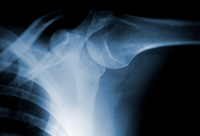 The FDA Patient Safety News video released in February of last year and titled "Chondrolysis with Continuously Infused Local Anesthetics" broaches the subject of further shoulder injury stemming from use of a should pain pump and—specifically—the direct infusion of pain medication to the shoulder joint itself.
The FDA Patient Safety News video released in February of last year and titled "Chondrolysis with Continuously Infused Local Anesthetics" broaches the subject of further shoulder injury stemming from use of a should pain pump and—specifically—the direct infusion of pain medication to the shoulder joint itself.It is no secret now, following adverse reaction reports and revelations that have rolled out over the last couple of years, that the direct delivery of pain medication following shoulder pain surgery should be limited only to the soft tissue surrounding the shoulder—and not the shoulder itself.
In fact, the FDA only ever approved the use of the shoulder pain pump for soft tissue delivery. An ongoing controversy holds that some pain pump manufacturers allegedly promoted the use of shoulder pain pumps in an intra-articular fashion.
That controversy notwithstanding, the FDA has "reminded" health care professionals that local anesthetics should not be used intra-articularly, either via manual injection or through infusion with a device such as a shoulder pain pump.
There is little doubt that further and usually irreversible shoulder injury has been shown to occur when pain medication is fed directly to the shoulder joint. The question that appears to remain unanswered, according to the FDA, is why?
"At this point it's not known which characteristics of the infusions may be causing the problem," said spokeswoman Anita Rayner in the FDA video released last year. "Whether it's the drug itself, the materials in the infusion device, or some combination of factors."
READ MORE PAIN PUMP LEGAL NEWS
It is for this reason that manufacturers of local anesthetics have been requested by the FDA to include warnings on its product labeling with regard to the issues surrounding shoulder pain pumps and direct, intra-articular use of pain meds directly to the shoulder—with a similar warning required of manufacturers for pain pumps.
Many young athletes—including adolescents—have suffered from a complete breakdown of shoulder cartilage following shoulder repair surgery involving the use of a shoulder pain pump, post-surgery. Since cartilage does not regenerate, many shoulder pain pump patients have required complete shoulder replacement, a procedure that will likely have to be repeated over time given the youth of many patients.
